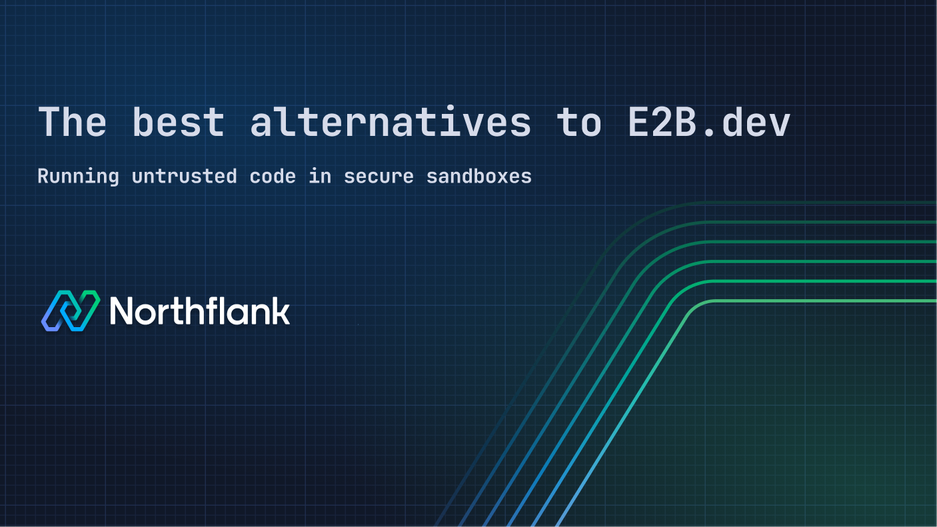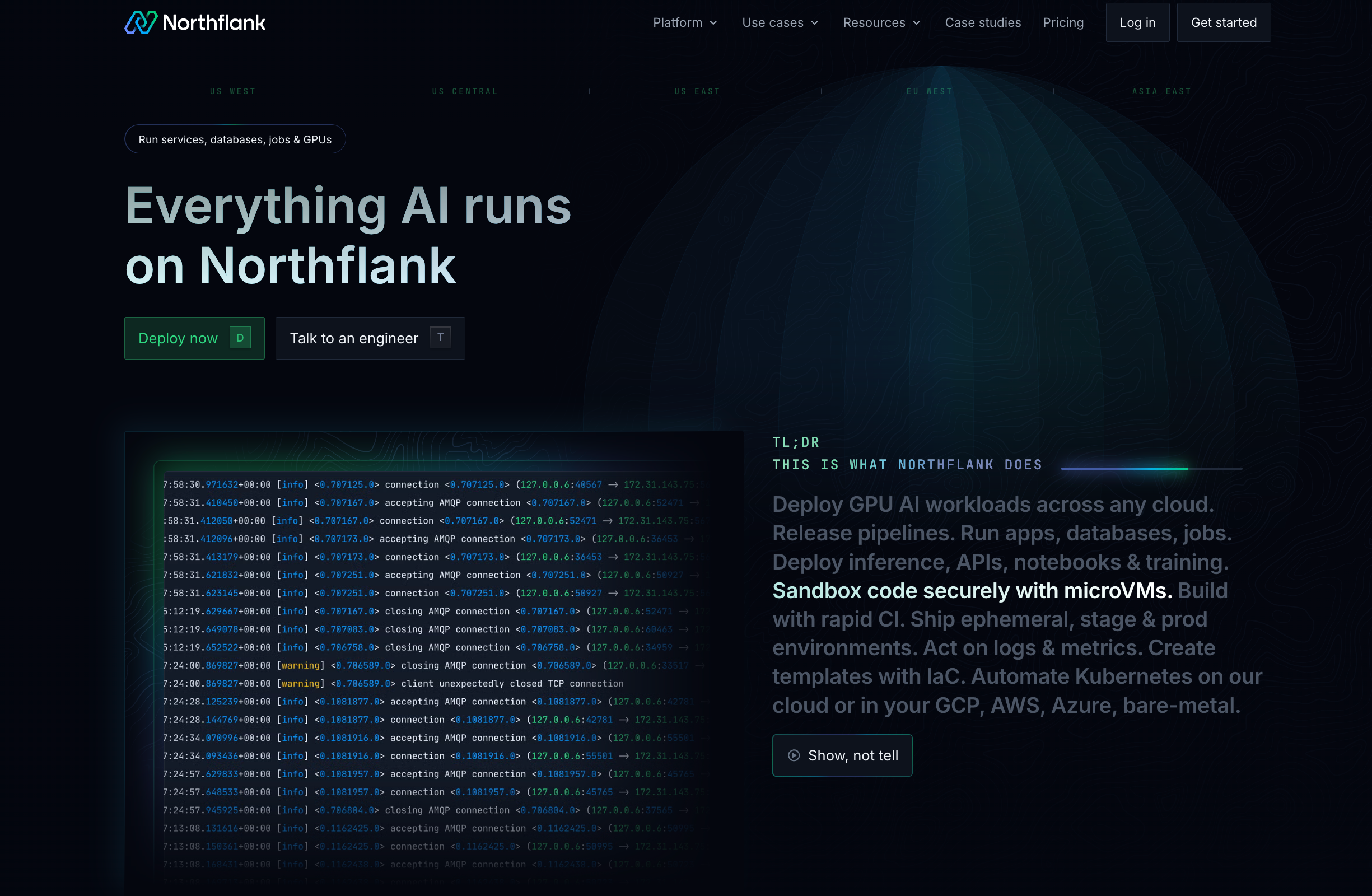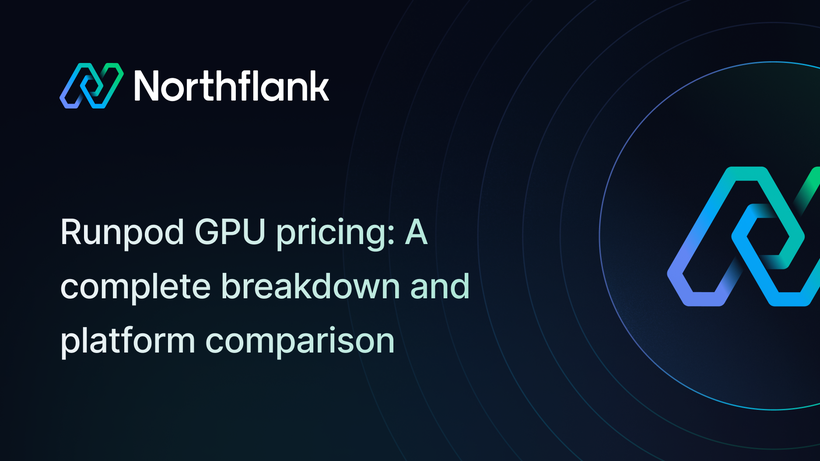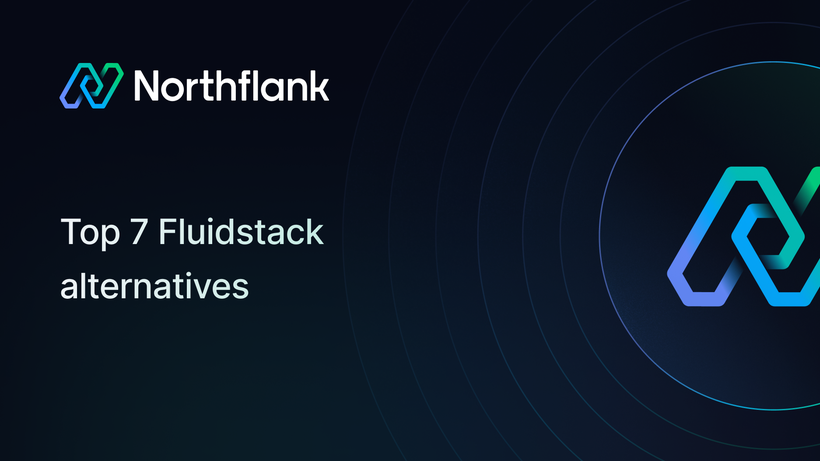

The best alternatives to E2B.dev for running untrusted code in secure sandboxes
AI developers are increasingly reaching for platforms that allow them to safely execute arbitrary or user-submitted code, typically generated by agents or LLMs, inside isolated, short-lived environments.
E2B.dev is one of the most well-known projects in this space. But it’s far from the only option, and for many teams, not the most suitable.
This article covers:
- What E2B Sandbox is and how it works
- Why secure sandboxing is essential for modern agent workflows
- Where E2B.dev falls short
- How E2B alternatives like Northflank, Modal, Daytona, and Vercel compare, based on latency, flexibility, and developer experience
If you’re evaluating secure sandbox platforms for running untrusted or AI-generated code:
- E2B.dev is good for experimentation. SDK-based, fast startup, but limited sandbox lifespan, region control, and lacks orchestration.
- Northflank offers a more flexible and production-ready option. You can run microVMs in your own VPC, keep sandboxes alive indefinitely, and integrate observability, Git, and custom toolchains. Better for long-running workloads, real apps, and enterprise control.
- Modal is fast and well-suited to Python workloads, but doesn’t provide microVM isolation or persistence.
- Vercel Sandbox is promising, but still early and limited to short-lived runtimes.
- Daytona is fast on cold start, but lacks streaming and long-session stability.
LLMs frequently generate code, either as part of agents, developer copilots, or internal tools. Executing this code introduces risk: it might be malicious, buggy, or resource-intensive. It might accidentally (or intentionally) read sensitive files, access the network, or overwrite system state.
Secure sandboxes solve this by:
- Isolating code execution in virtualized environments (usually microVMs like Firecracker)
- Restricting access to system resources and networks
- Enforcing execution limits, quotas, and lifespan
- Ensuring multi-tenancy without leakage between user sessions
- Users are uploading or generating scripts
- AI agents are invoking external tools or writing to disk
- You need to support high concurrency and low latency while maintaining safety guarantees
E2B.dev is an open-source tool that lets developers spin up isolated Firecracker microVMs to execute AI-generated code. It comes with Python and JavaScript SDKs, supports browser-based and local development, and integrates with tool-calling interfaces like Anthropic’s Claude.
- Fast startup (~150ms under ideal conditions)
- Firecracker-based isolation is safer than containers
- SDKs make integration simple
- Sandbox sessions are short-lived (5–10 minutes in practice, even on paid plans)
- No orchestration or lifecycle management
- Only PaaS offering is officially supported, BYOC requires deploying and maintaining their infra yourself
- Regional control and infrastructure flexibility are limited
- High costs at scale
-
Free: $0/month with usage limits (2 vCPU, 512 MB RAM, ~1hr sessions)
-
Pro: $150/month + usage fees (~$0.000014/vCPU-s)
-
Enterprise: Custom pricing with higher limits
To run persistent workloads or allow users to return to a sandbox session later, you must upgrade to Pro and build custom keep-alive workarounds.
E2B.dev and E2B.dev alternatives are typically used to:
1️⃣ Safely run LLM-generated code via tool-calling
2️⃣ Power developer agents or internal copilots
3️⃣ Launch live developer sandboxes for testing or debugging
4️⃣ Run compute or visualizations in the browser and pass back results (e.g., plotting NVIDIA stock or computing summary stats)
5️⃣ Run MCP servers
If you’re building an AI agent that calls external tools, an IDE-like app for prompt-driven development, or any product where end users run code on shared infrastructure, you need secure sandboxing.
Here are the top E2B alternatives.
1. Northflank - #1 E2B.dev alternative for secure sandboxing

Northflank is a developer platform that supports running secure microVMs with Firecracker, Kata Containers, Cloud Hypervisor, or gVisor.
It has been in production since 2019 and executes over 2 million microVMs every month. It supports short-lived jobs, long-running services, BYOC, and multi-tenant sandbox orchestration.
Strengths:
- MicroVM isolation with full Kubernetes orchestration
- Sandboxes can persist indefinitely
- Works in your cloud (VPC), with full observability and cost tracking
- Polyglot by design: supports any language, runtime, or framework
- Git and CI/CD integration built-in
- Supports developer agents, untrusted jobs, and long-running AI workloads
- Contributes actively to OSS projects like containerd, Kata, QEMU
Limitations:
- Cold-start latency is higher than container-only tools, though tunable
- SDK could be simplified (Northflank is actively working on this)
Who it's for:
- Teams building serious agent infrastructure, internal devtools, or production-grade SaaS platforms
- Companies that need enterprise controls or custom cloud environments
- Developers who care about long-lived stateful sandboxes
Pricing:
- Starts low (usage-based), with no forced plan tiers
- Supports per-second billing, spot compute, and GPU options
- No minimum fee to access long-lived sessions
A developer using Northflank for spinning up agent sandboxes put it this way:
"With E2B, a sandbox dies after a few minutes. With Northflank, it stays alive until I kill it. That makes a huge difference when users come back to projects days or weeks later."
| Feature | Northflank | E2B.dev | Daytona | Modal | Vercel Sandbox |
|---|---|---|---|---|---|
| Isolation method | MicroVMs (Firecracker, Kata, gVisor, CLH) | MicroVMs (Firecracker) | Containers (with fast image caching) | Containers | MicroVMs |
| Sandbox lifespan | Unlimited (until terminated) | ~5–10 min typical, max 24h on Pro | Varies (minutes–hours), no persistence | Stateless (function-based) | Max ~45 min (beta) |
| Startup latency | Varies, can be tuned | Very fast (~150ms) | Extremely fast | Fast | Fast |
| Persistence | Yes (stateful, can resume) | No (state loss after session ends) | Limited | No | No |
| Git & CI/CD Integration | Built-in | Manual / SDK | Partial (via config) | None | Integrated with Vercel Git flow |
| Streaming support | Yes | Yes | No (latency issues) | Yes (for Python stdout) | Yes |
| Regions & BYOC | Multi-region, full BYOC/VPC support | Single region PaaS, OSS self-hosting (limited) | Handful of regions, no BYOC | Single region, no BYOC | Vercel platform only |
| SDK / API | REST + CLI + SDK (improving) | JS/Python SDKs | REST API | Python API | JS SDK (in beta) |
| Pricing model | Usage-based (CPU $0.01667/hr, RAM $0.00833/hr) | $150/mo Pro plan + usage (~4x higher CPU cost) | Paid (undisclosed), no free plan | Usage-based (per function) | Plan-based |
| Who it's for | AI infra teams, SaaS platforms, devtools | Hackathons, LLM demos, short-lived agents | Dev env bootstrapping, speed-first use cases | Python-based tooling, bursty compute | Agent UI demos, edge code exec |
Daytona emphasizes developer environments. It’s fast on cold start and supports image-based sandboxing.
Strengths:
- Extremely fast initial boot
- Can pull Docker images quickly from Git
Limitations:
- Weak on streaming and interactive outputs
- Feels less cohesive, requires custom patching
- Session persistence and developer ergonomics lag behind
Who it's for:
- Teams focused on reproducible dev envs with tight image control
Pricing:
- Commercial plans, pricing varies
Still in beta, Vercel Sandbox provides ephemeral microVMs with a ~45-minute lifespan. It integrates tightly into the Vercel platform, intended for devtools, agent playgrounds, and code demos.
Strengths:
- MicroVM isolation
- Simple to get started
- Integrated with Vercel’s broader deployment pipeline
Limitations:
- Runtimes capped at ~20–45 minutes
- No orchestration, BYOC, or long-running agent support
Who it's for:
- Devtools demos or short-lived interactions
- Vercel-native teams
Pricing:
- Bundled into Vercel plans
Modal recently added support for Python sandboxes aimed at code execution use cases. It’s very fast to boot, container-based, and designed to scale horizontally via API.
Strengths:
- Excellent cold-start speed
- Good for short-lived execution tasks
- Built for Python workloads
Limitations:
- No microVM isolation
- Sessions are ephemeral
- No BYOC or VPC support
Who it's for:
- Developers running transient Python workloads
- Teams with stateless agent jobs
Pricing:
- Pay-as-you-go based on function duration and resource allocation
E2B.dev helped popularize the concept of secure sandboxes for AI tools, but most teams building real-world agents or developer-facing products will need more control, persistence, and scale than E2B supports today.
If your use case requires:
- Long-running sandboxes
- Multi-tenant environments
- Running inside your VPC
- Observability, quota controls, and Git integration
- Production-ready support
Northflank is the better fit when you’re looking for E2B alternatives.
It combines microVM-level security with full lifecycle orchestration and a mature developer experience. You can spin up workloads in your own cloud, stream output in real-time, and integrate directly with tool-calling flows via SDK or API.
If you're evaluating platforms to run untrusted code safely, Northflank should be on your shortlist.
Beyond Northflank, platforms like Daytona, Modal, and Vercel offer variations of secure sandboxing.
However, none combine microVM isolation, long-running stateful workloads, polyglot support, BYOC, observability, and enterprise-grade orchestration.


